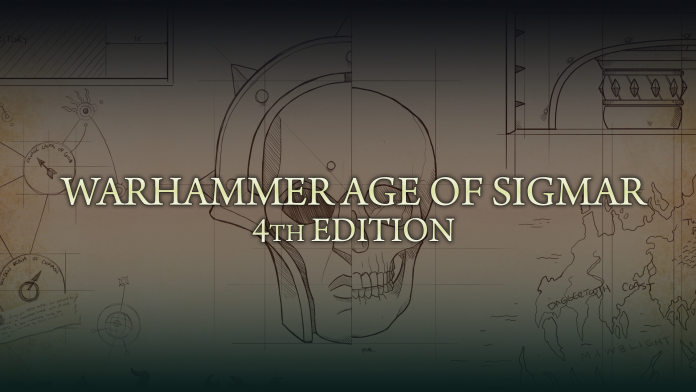Goonhammer has received some of the launch content, via Games Workshop, to create this review and overview. Over the coming weeks, and with the benefit of having played dozens of games, we will be having faction experts provide insight into how they are building and running lists with these factions. For this overview we’re looking at what stands out for the faction, how much has changed, and how we would approach dealing with some of the common threats that are present in all wargames.
Armies of Renown became a thing during the last year of third edition Age of Sigmar and, apparently, are coming in strong into fourth. It’s really interesting to see these now and it become apparent that some of what third edition Armies of Renown were doing was testing out some mechanics for fourth edition. The most obvious of this is the Fyreslayer Magmadroth hitching becoming how Kharadron ships work in the new edition.
Each of these is basically a very self-contained army. The only rules that you use are from the corresponding army’s warscrolls for the units you’re allowed to take. You do not get to use any of the army’s usual faction rules and instead use the Army of Renown’s. In some cases these just add back in some of the faction rules anyways, in others they fully replace them.
None of them allow Regiments of Renown, either, but that’s listed individually so maybe there will be more in the future that do allow it?
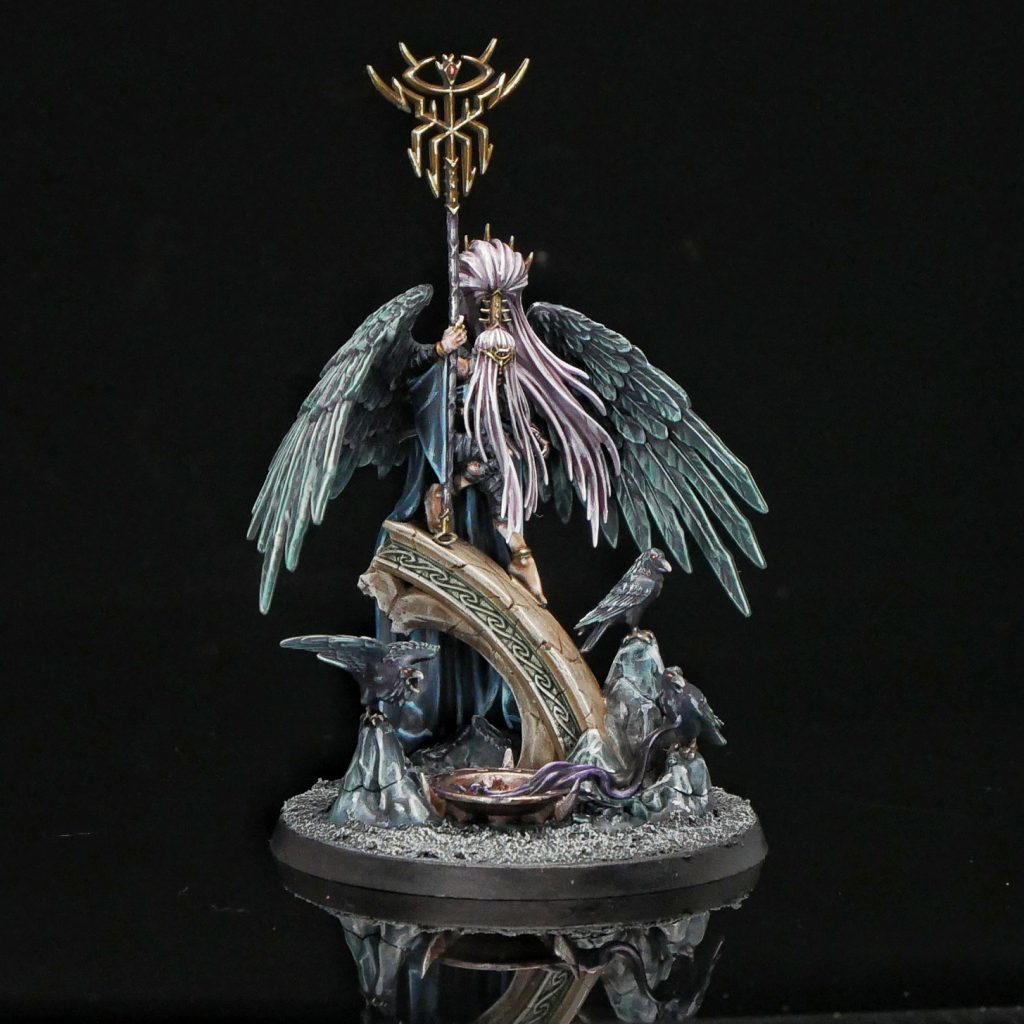
The Croneseer’s Pariahs
- Krethusa the Croneseer (must be included, must be your general)
- Daughters of Khaine Aelf units
- NOT Morathi or Shadwon Queen
This is basically the same as before: You take Krethusa to really use the army’s abilities and then take a couple Cauldrons of Blood and a bunch of aelfs. No Morathi, no snakes. The Cauldrons start the game “empty” and can be “full” by killing models with the Cauldron itself or using a sacrificial ability to allocate D6 damage (ignoring wards) to a unit (friend or enemy) and fill the cauldron; previously that latter ability needed a dice roll and now it just works! While full, your Cauldron gains a 4+ ward and aura of -1 to hit for friendly units.
Krethusa hands out extra rend to non-hero infantry units nearby turning all those Rend ‘-‘ attacks into ones that can actually pierce some armour; for Sisters of Slaughter, going up to Rend 2 against Infantry just picks them up quicker. Being able to retreat with a cavalry unit during your opponent’s charge phase is very interesting timing; your opponent makes all of their charge rolls and moves, and then after those are all done, on a 3+ you make the retreat. Combine with the Prayer to give them Fly and it’s even easier to get to safety and maybe onto an objective. Just roll a 3+!
You only get one heroic trait and artefact of power; the former stops units in combat range from using any commands and the latter inflicts mortal damage at the end of each turn on a dice roll. Removing commands is huge, locking units into combat by stopping Power Through will always be big.
You get a whole new Prayer Lore that can make units Fly and move faster, give 5+ wards to units, and curse enemy units to inflict mortal wounds on themselves when attacking. Slapping an enemy unit with a high number of attacks to just put them off even wanting to charge in is great.
All in all it turns into being an army made up of Cauldron castles and hyper mobile cavalry for board control and objective play; a fun alternative to Daughters of Khaine.
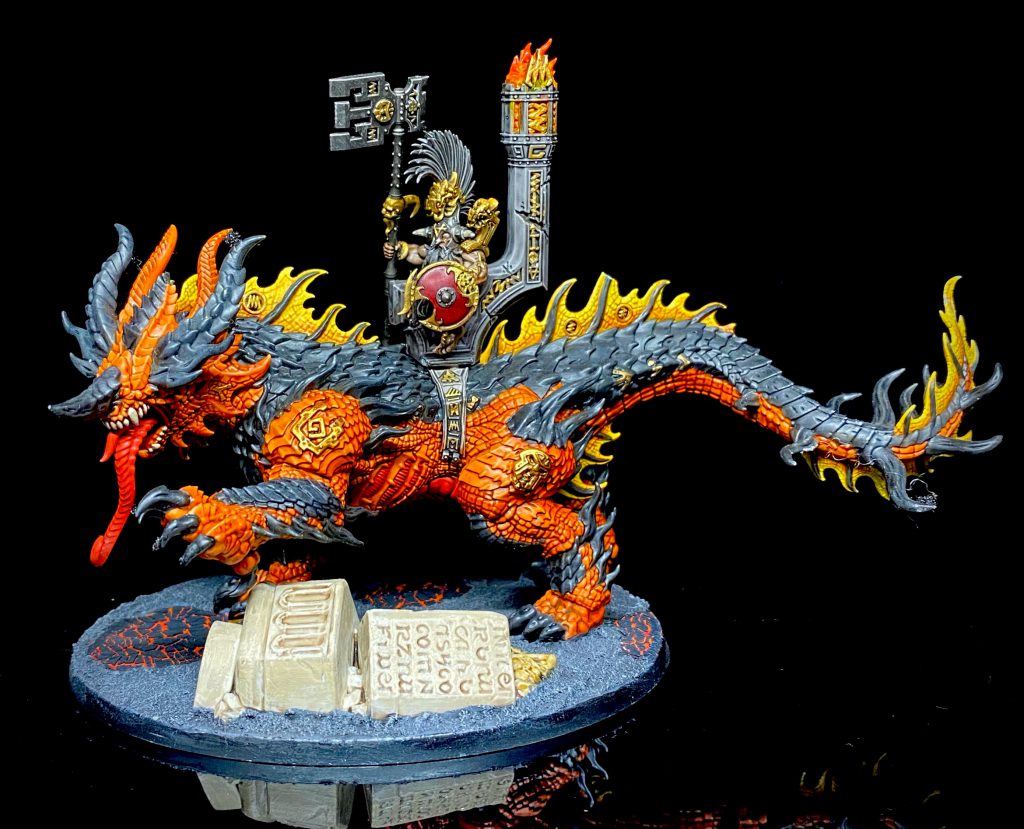
Lofnir Drothkeepers
- Any Magmadroth
- Runemasters
- Runesmiters
- Runesons
- Vulkyn Flameseekers
- NOT faction terrain
While you can take a Runemaster there’s really not much reason to; you’re not able to use the army’s normal Prayer Lore and have no runes to empower. This is all about fielding probably four (maybe more) units of Flameseekers and a few Magmadroths to cart them around; Runesons being the cheapest of those might work out the best, but a Runesmiter for prayers will be handy. Flameseekers can’t be reinforced so they’ll always be eight slayers and a baby droth.
The prayer lore is just to summon a Molten Infernoth, same as the normal army, or to turn one Magmadroth’s shooting attack to a flat 3 damage instead of D3. Nothing amazing here, but the Molten Infernoth will often put in work.
The magmadroths cart around one hero or one unit whenever they make a non-Charge Move ability. That includes a Redeploy or Power Through command to help slingshot some guys around into a better position for next turn or help get them to relative safety. However they also can’t make Charge moves later in the same turn, so that mobility is great but doesn’t help them hit combat in the same turn. Enemy Monsters in combat with two or more Flameseeker units have Strikes Last which is great…if your opponent has Monsters and if you can get two units into combat with them.
You get three rampages to use in each combat phase, once per army. Roll a 3+ to remove ward rolls from an enemy unit in combat range; wards are pretty big and even removing a 6+ will make a world of difference. Roll two dice and do some mortal damage, on easier rolls if you’re targeting a monster; extra damage before the attacks start flying around the table is never a bad thing and into monsters can mean the difference of bracketing their profile. Lastly, on a 3+ gain an extra tick of rend with all attacks against the target; that’s for all of your units attacking.
As with most Armies of Renown, you get one heroic trait and artefact of power. The former gives off an aura for non-monster units to gain Anti-Monster (+1 Rend) which Flameseekers already have, so it will only affect any other heroes you happened to take that aren’t on Magmadroths. Which probably isn’t (m)any. The latter makes enemy monsters contesting the same objective have a maximum control score of 2. Pulling Mega Gargants down to a control of 2 is incredibly amusing, and game winning.
This really is the gang-up-and-fight army with abilities that will make it much easier to take down units, especially monsters, when you set up your charges correctly with multiple units.
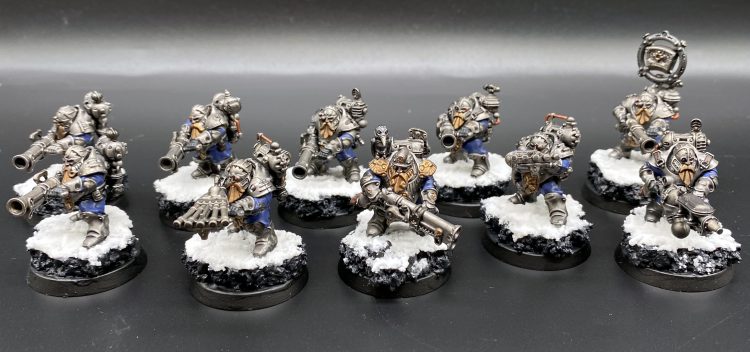
Grundstock Expeditionary Force
- Admirals
- Navigators
- Endrinmasters (both kinds)
- Codewrights
- Aether-Khemists
- Thunderers
- Gunhaulers
The most awkward part of this army now is how your regiments work out. You’re only allowed a single Gunhauler in any hero’s detachment, aside from Admirals, so you’re suddenly staring down the barrel of a very high drop army with a lot of heroes to make this work; alternatively you can be higher-drop with a bunch of Auxiliary units but handing over extra CP to your opponent is often a terrible idea. If you played this before: the double-shooting Thunderers are gone and everyone is happy about that!
The Gunhaulers are able to cart around one unit of up to 5 models whenever they move, just like the core army. Infantry units gain Crit (Mortal) while contesting objectives but only with melee weapons; it helps when they get bogged down in combat but that’s often when they’re dying anyways. End of every turn you can pick an enemy unit and reduce its control score by 1 for each damage point allocated to it by a shooting attack that turn, capping out at 10; situationally that’ll help but generally probably not make a big difference. Each of your own shooting phases a unit gets to roll a 3+ to get an additional attack with one of its ranged weapon profiles; getting a third shot with a mortar for extra D3 damage will be the best use case.
Your heroic trait gives a friendly unit within 12″ a 5+ ward for the rest of the turn when they use All Out Defence, which can even be for one of your boats if you want; that can work twice in both shooting and combat phases on two different units, too. The artefact is a Ghost Buster backpack that gives you a free Banishment roll whenever a Manifestation within 9″ makes a Shoot or Fight ability. That’s incredibly specific, but you can definitely see a Khemist going around hoovering up endless spells.
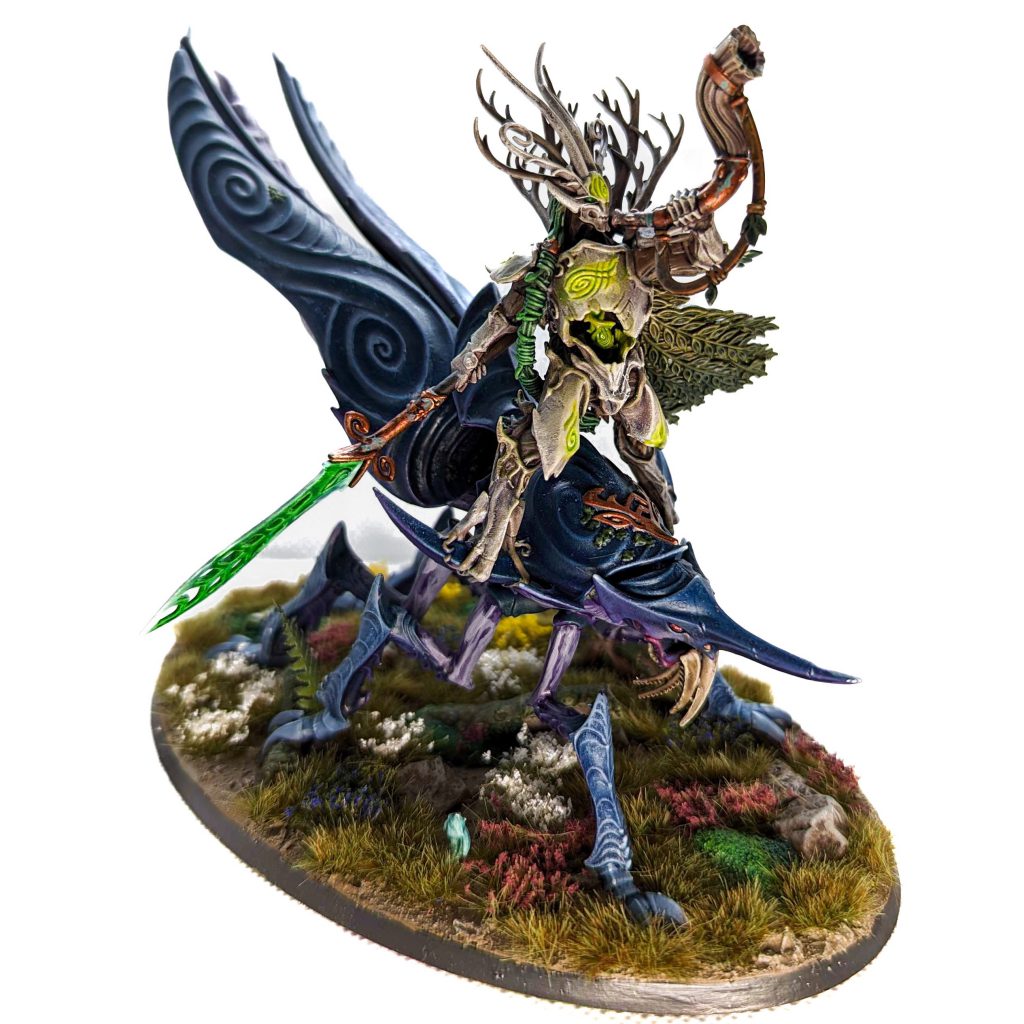
The Evergreen Hunt
- Belthanos (must be included, must be your general)
- Arch-Revenants
- Revenant Seekers
- Spiterider Lancers
- Kurnouth Hunters (any weapon)
Turn by turn you pick an enemy unit to hunt down, gain “chords” depending on a list of things to do with that target and previously killed ones, and then gain a list of abilities depending on the number of chords you have. Typically you start off with some very easy to kill targets, using your Kurnouth Hunter bows to take them out quickly so you can pick a new target in the next battle round to stack those buffs more easily. It’s very cool and thematic, and if I had to play a Sylvaneth army would probably lean into this theme.
Once per battle you can spend a command point to change your target to something else, maybe you made a poor decision or something else has happened so it’s nice to have the flexibility. Each unit within combat range of a terrain feature, not just woods, heals 1 in your hero phases; really nice that they don’t have to be woods and battleplans recommend a large number of terrain so it’ll be easy to use. The Merciful Strike rampage is amazing too, you pick something within combat range, roll a D6 and add the number of damage it currently has; if the roll exceeds its health characteristic then a model from the unit is slain. Against larger targets you’ll need to be 3-4 damage points away from killing it to be somewhat reliable but having the chance to remove something before any attacks are made is fantastic.
The heroic trait (which will be for an Arch-Revenant) heals 3 instead of just 1 as above and their artefact will be a once per game ability to just gain 1 chord. Being able to easily stack up to the next tier of chord-power will be great when used right.
It’s very cool and thematic, and if I had to play a Sylvaneth army would probably lean into this theme.
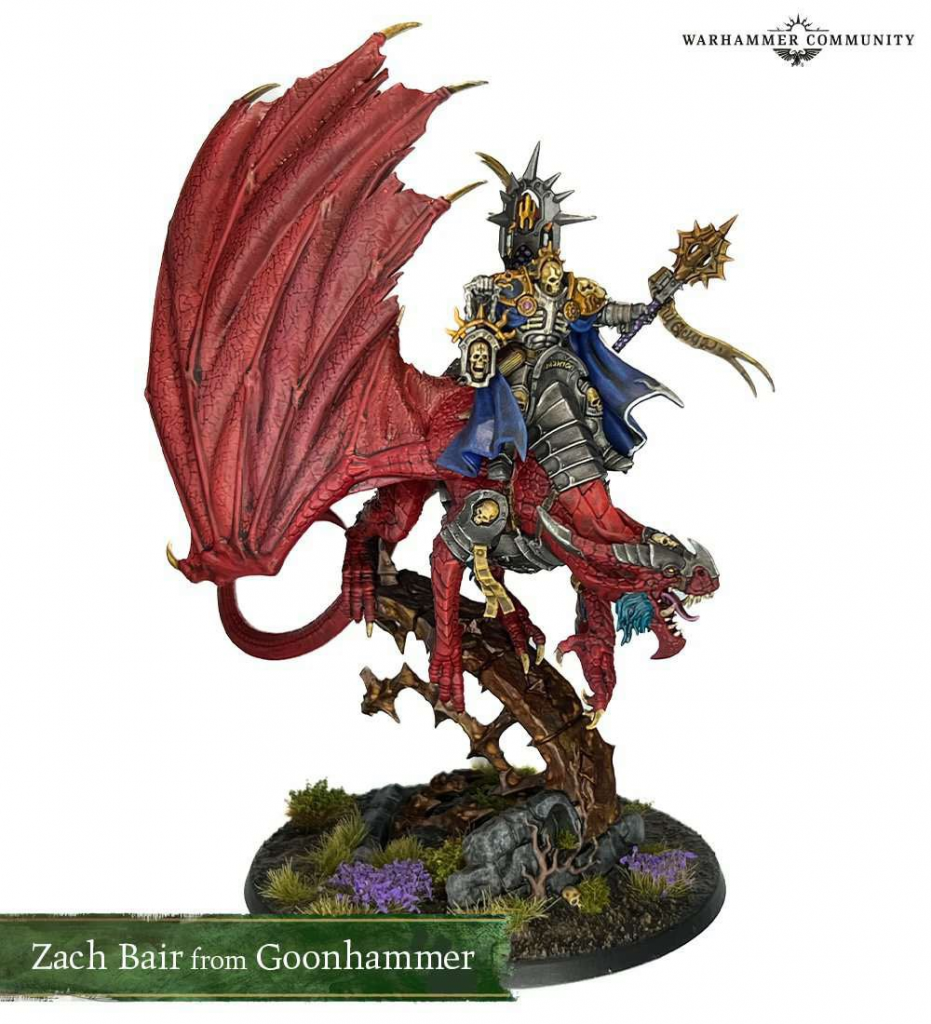
Draconith Skywing
- Ionus Cryptborn
- Krondys
- Karazai
- Knight-Draconis
- Stormdrake Guard
Here there be dragons! Stormcast dragons was a hell of a rollercoaster in early third edition and then a couple years later got the first iteration of this: Oops-All-Dragons. I also think it’s quite good, actually.
Ionus gains a 4+ ward! Yay! But only when there are Stormdrake Guard nearby and when he makes a ward they have to suffer a point of damage. Passing off wounds is very rare in this edition but Ionus is worth keeping alive so that’s fine. Hero Companion weapons get an additional attack when there are two or more Stormdrake Guard units near them, making the dragons hit a little harder.
The Prayer Lore is only for Ionus to use, either healing units up to 2D3 or making it harder for enemy wizards to cast spells. That second one, though; if you chant on a 12+ then all enemy wizards and priests are at -1 to cast and chant rolls, regardless of range to anything, even if Ionus dies. That’s really good. On the other side is the one spell that Krondys gets to use to add 5 to a unit’s control score, which is fine and situationally gives you an objective. You can also summon the Everblaze Comet which isn’t great but combined with the aforementioned prayer is pretty amusing.
You get two new rampages to use. The first is fine, reducing control scores of a few enemy units in combat, but the other is great, subtracting 1 from an enemy unit’s wound rolls. This is a very elite army so any amount of damage mitigation you can get is incredible.
If you really, really, just want to play Dragons then you’re probably going to do it this way instead of with the Stormcast Faction Pack.

The Swords of Chaos
- Archaon the Everchosen
- Abraxia, Spear of the Everchosen
- Varanguard
That’s it. That’s the list. If you take both Archaon and Abraxia then you get 6 whole Varangaurd and a nice 130 point bid for that extra turn 1 command point. With Archaon instead you get 9 Varanguard and an even larger bid…or Abraxia with 15 Varanguard and only a small 90 point gap to 2,000 points. Regardless of how you price this up you’re going to be down massively on points and it doesn’t feel thought-through.
For four battle rounds of the game, one of the Chaos gods will make a demand of your army (don’t worry, you get to choose which one; the gods aren’t that fickle) and something happens. This ranges from a simple +2″ move or extra rend to dishing out mortal damage from range and healing wounds to gain a 6+ ward. These are really good effects and there will be a time for each, easily. Extra movement early game to get into position, extra rend on the big-charge turn, some healing and ward to keep going, and then some mortal damage to clean up. It doesn’t have to be that order; you’ll have to decide what’s most important each battle round!
One unit also just gets to deepstrike, setting up in reserve start of game. Dropping in Archaon where you need him is great but even better when you get to avoid any sort of alpha strike your opponent has.
Now this part is incredibly cool. Up to three Varanguard units can gain a First Circle Title of a passive ability to just have all game long; you just can’t take the same one more than once. The options range from extra movement, health, damage with companion weapons and gaining a 6+ ward or +1 attack when in enemy territory. The +3″ move and 6+ ward will easily be the first two chosen.
The “best” iteration of this list is probably a one-drop Abraxia list with 3 units of First Circle Varanguard reinforced, and then a little 3 man unit running around doing battle tactics.

Tribes of the Snow Peaks
- Darkoath Units
I love when things are simple like that. If you’re keen to just play all-Darkoath, then here you go. The whole army is all about timing Warscroll Oath abilities to gain Oath points and then use these new Oath abilities for different effects such as extra attacks, extra rend, run and charge, or a defensive 4+ ward. Being able to pick the ability you need when you need it is a very powerful tool to have and can keep your opponent guessing as to what will happen turn after turn.
Your heroic trait gives +1 to hit for nearby units and artefact is a once-per-game D6 sacrifice points to a Wilderfiend. Both are very solid abilities and able to spike high on that D6 for the Wilderfiend will be great, so naturally you’ll only ever roll a 1!
There’s not a lot to say here; this army is still pretty new anyways but being able to take a full army of just Chaos-worshipping humans and weird Wilderfiend beasts is very thematic and pretty cool.
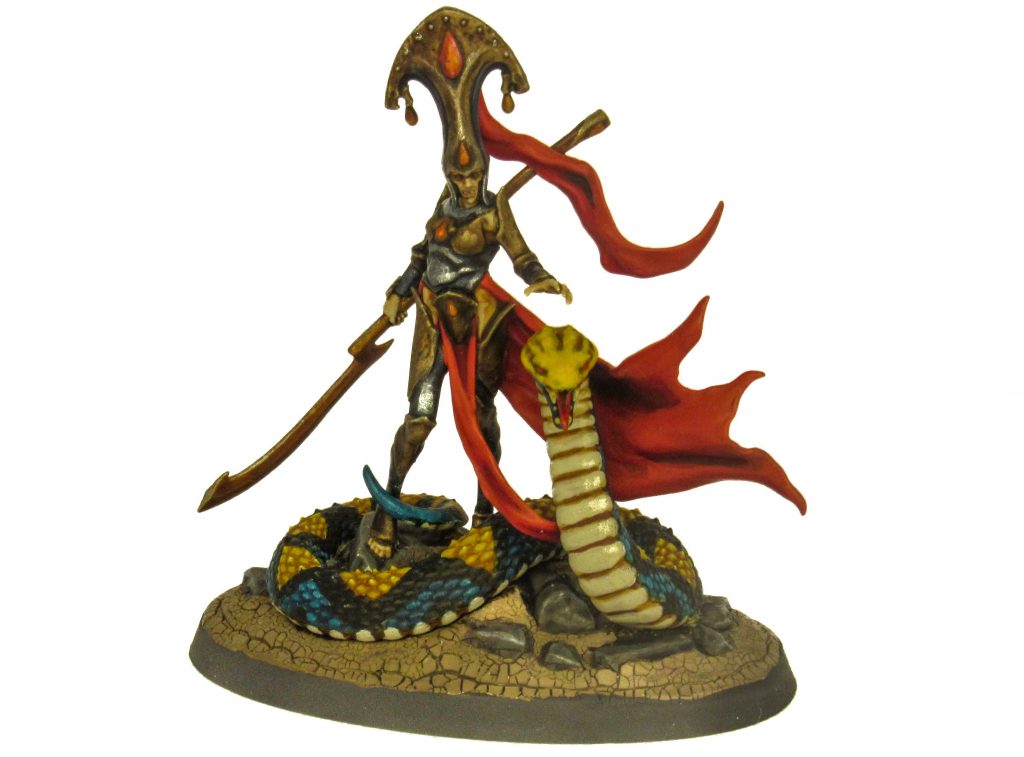
Scions of Nulahmia
- Sekhar (must be taken, must be the general)
- Coven Throne
- Bloodseeker Palanquin
- Vampire Lord
- Dire Wolves
- Fell Bats
This also modifies the normal regiment options allowing any Hero to take Vampire Lords in their regiment. So, yes, you can have an army of just vampires if you’d like!
The army works off a series of “exquisite plots,” each chosen once per game during your own hero phase. Your chosen plot gives a friendly unit a buff for the turn and if they accomplish a goal gain a game-long ability to use. For example, you get +1 to cast rolls with a wizard and if they successfully cast any spells add 1 to their power level for the rest of the game. Very simple; just don’t roll poorly! These are all relatively achievable and gives the feel of leveling up your vampires and units as the game goes, which is pretty cool.
The heroic trait brings a slain unit of wolves or bats back at half strength. The Amulet of Leeches artefact gives the bearer a 5+ ward while in combat range of friendly bats or wolves, but when it makes a successful 5+ ward roll then a bat or wolf has to suffer a point of damage that can’t be negated with their own ward. It’s the new version of bodyguard, same as Ionus above.
With the army you get your very own Spell Lore to return slain models to friendly units, kill friendly models to heal the caster, and add extra attacks onto friendly units in a bubble. All solid and work well together. Being able to first kill off D3 wolves followed up by reviving them pretty funny.

Trugg’s Troggherd
- Trugg (must be included, must be your general)
- Dankhold Troggboss
- Dankhold Troggoth
- Fellwater Troggoths
- Rockgut Troggoths
- NOT Faction Terrain
First off, not having the Loonshrine is pretty big. You can never return any models back to the table; when they’re dead they’re just dead! Secondly you don’t get the Light of the Bad Moon at all, so no +1 saves for any of your troggs at any point. Instead you get an effect to ignore a point of rend from melee attacks during the second and third battlerounds. It’s more reliable than the random moon but not nearly as good as +1 save; mostly because it only works against melee attacks making your troggs very susceptible to shooting!
Fortunately, though, they’ve added in the after-Fight healing so you’re not losing that by choosing the Army of Renown over vanilla Gitz. Trugg’s Leystone also effects all troggs on the table instead of only the ones within 12″ of him, but not the 5+ ward since that only affects Trugg himself. You do get to deepstrike any unit next to a piece of terrain as well, setting it up off the table during deployment and dropping them in mid-game. That can be Trugg, a Dankhold, or even a unit of 6 Rockguts ready to go.
One of your Troggbosses gets Loonstone Teef to Fight a second time with Strikes Last and Crunchy Shinies to gain +3 run and charge rolls; both are once per game abilities so using them at the “right” time will be big. Deepstriking in a Troggboss and then making a 6″ charge is the obvious choice here, and good.
Overall it’s hard to ignore the benefits lost by not playing Oops All Troggs in a regular Gitz army for full benefit of the Bad Moon and recursion of the Loonshrine.
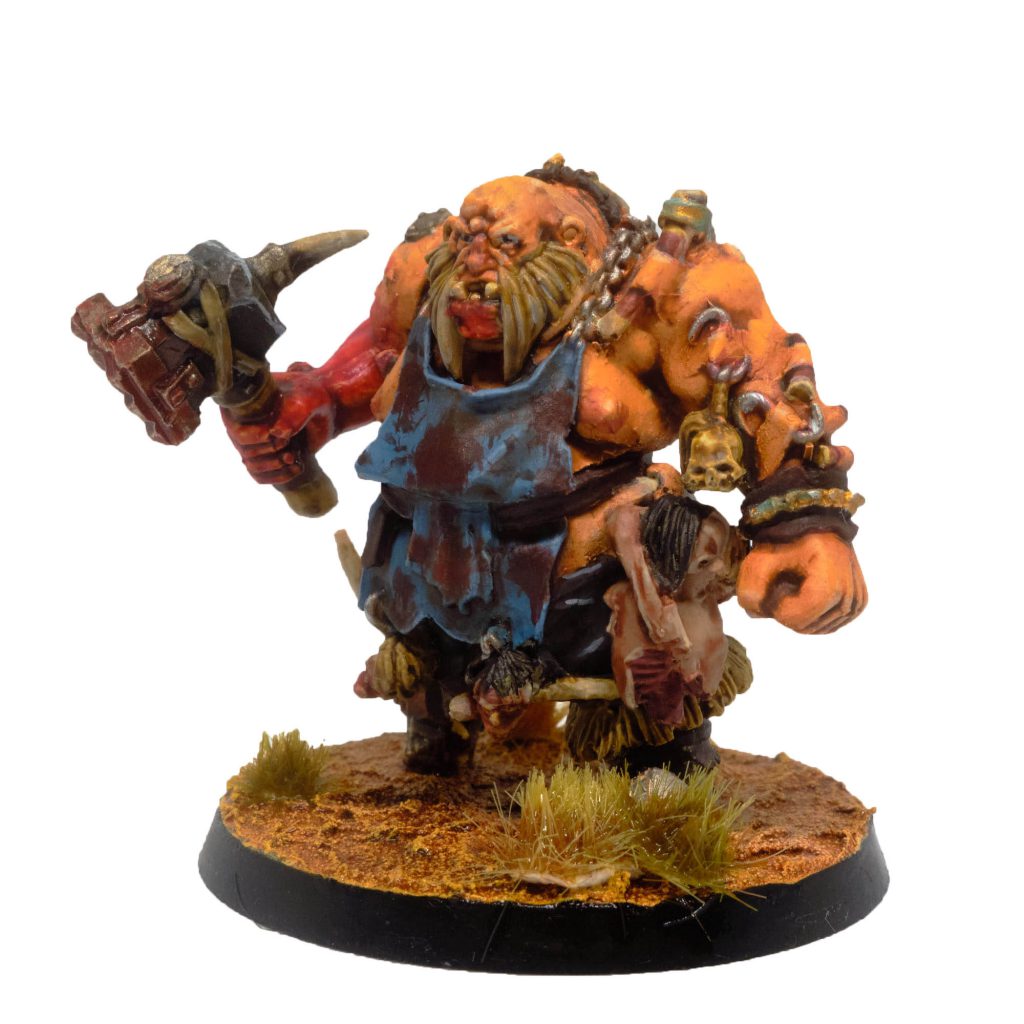
The Roving Maw
- Gutbuster Units
- Gorger Mawpacks
- NOT a Great Mawpot
The foot-slogging Ogor army list. You can take the Mawpit at least, so not as big a loss as other Armies of Renown. Actually, you need it to make this army work since all of the abilities really revolve around having it, which makes this a difficult army of renown to like since the Mawpit can just be shot at, charged, and destroyed with relative ease. Gorgers can also run and charge when wholly within 3″ of a terrain feature, which is mostly useful for running through woods. It has a Spell Lore to help make the Mawpit do things and another to give the caster 2 extra rend on their own weapons only…it feels odd.
Your Head Butcher heroic trait gains an extra “tasty morsel” for the Mawpit and the artefact does at least give the mawpit a 5+ ward but it’s still only a 5+ save with 10 health. It won’t take much to remove that from the table and leave you with a set of army rules that don’t actually do anything for you.
Honestly this might be the only one that I recommend just avoiding, while others are thematic, fun, and playable even if not optimal this just has far too high a chance of not even being playable. You give up a bit too much from the standard Ogor faction pack.
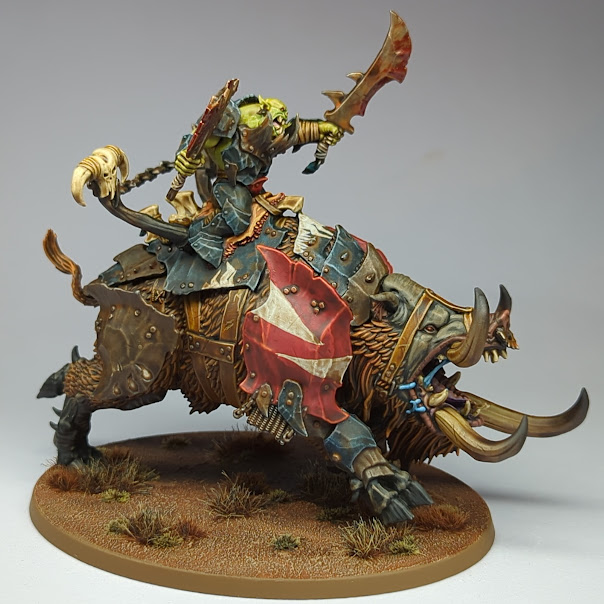
Kazogg’s Grunta Stampede
- Tuskboss on Maw-grunta
- Maw-grunta with Hakkin’ Krew
- Maw-grunta Gougers
- Gore-grunts
All. The. Pigs. These previously just weren’t great with a mechanic that seemed cool on paper but took too long to get going on the tabletop to actually use. Now momentum works a bit better, the units are just generally a bit better at their relative cost, and the army of renown boosts their abilities in a way that makes a bit more sense.
As a passive ability the units add the Battle Round number to their movement characteristic. That seems minor in the early game but even during your second turn boosting maw-gruntas up to 12″ and gore-gruntas to 11″ will make a big difference. They get their own Waaagh! ability to gain extra attacks, re-roll charges, and inflict more mortal damage when they charge in. You can even move a unit before the game starts to get into position, start taking a flank, and line up a charge when it comes around to your turn.
This is just a very thematic army list and feels a lot better to place down on the table. Is it better than just slamming down 60 Ardboyz? Maybe? Time will tell. And you’ll tell me when you try it out, so please do.

King Brodd’s Stomp
- King Brodd (must be included, must be your general)
- Mega-Gargants
- Gargants
The whole roster. You can just take all of it. This is, really, just a different way of using the exact same models you already have; unless you don’t have Brodd in your normal list, that is.
Brodd gains a similar bodyguard ward to Ionus. When another unit is within combat range of Brodd, he gets a 5+ ward, but when he makes that ward the other Gargant has to suffer a point of damage that cannot be negated. Brodd is more important than a couple Mancrusher Gargant losers so keep one or two by him as wound batteries.
Mega-Gargants can still pick up and throw terrain around, however it’s now a Rampage done during your own shooting phase and just deals mortal damage; first to any units on the chosen terrain feature at 2+ D3 damage and then 3+ D6 damage to the target of the attack up to 18″ away. Mortal damage shooting has basically been removed so it’s interesting to see this changed to mortal damage, my assumption here is that they didn’t want terrain being thrown around as Covering Fire. Although that would have simply ruled and should have done that. There are four more rampages like moving 3D6″ over screens after charging, removing artefacts of power from enemies, dealing mortal damage based on armour saves (the better, the more damage), and adding up to +6 attacks to their Stomp weapon profile.
Their heroic trait allows that Gargant to make the 3D6″ move rampage if another Gargant does it, even if your hero has already done another rampage. Lots of rampages. The Lucky Shiny Hat gives a Gargant a 4+ ward against spells, prayers, and manifestations.
Lastly, Brodd gets a whole second prayer giving off a 12″ aura of +1 attack or +2 if answered on a 9+ instead of a 4+. These are all very high quality attacks, so getting to roll extra dice on them is incredibly powerful.
There’s lots of fun to be had here. I expect Sons players will be testing this out as much as their regular army rules since it really doesn’t require owning anything too special or different, just having Brodd…
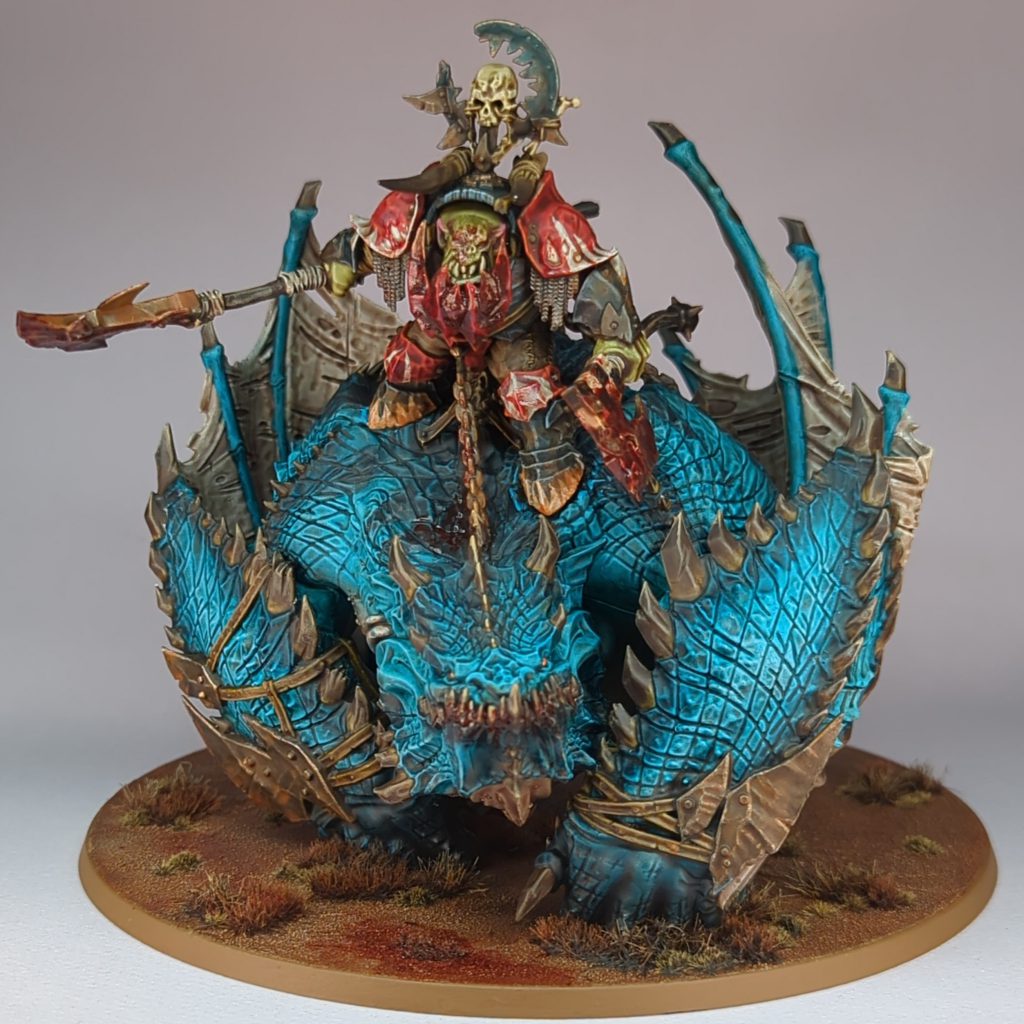
Pulling It Together
While all of these are incredibly thematic to what they’re pushing the player to do and field on the table it can’t help but feel somewhat imbalanced between each other. Some of these players will entirely pass over and not even consider taking over their normal faction pack, the Ogor one most of all. Others, like King Brodd’s Stomp are actually pretty solid and don’t end up changing your overall playstyle too drastically, just what you get to do changes. And then some like the Kharadron Overlords one completely changes how you even approach list building for the sake of making it work.
Overall these are fine and it’s fine that they exist for those that want to use them. I really think they’ll mostly be seen in pick up games, friendly gaming nights, and just messing around for something different on the table for regular, more casual, gamers. I am incredibly curious if we’ll continue to see more of these pop up through fourth edition, considering the (sometimes drastic) changes made to these from their third edition counterparts I think the answer is “likely”.
Have any questions or feedback? Drop us a note in the comments below or email us at contact@goonhammer.com. Want articles like this linked in your inbox every Monday morning? Sign up for our newsletter. And don’t forget that you can support us on Patreon for backer rewards like early video content, Administratum access, an ad-free experience on our website and more.
